
TheClimateChanger
-
Posts
1,881 -
Joined
-
Last visited
Content Type
Profiles
Blogs
Forums
American Weather
Media Demo
Store
Gallery
Posts posted by TheClimateChanger
-
-
Interesting long-term data from Lake Mendota in Wisconsin.
-
Same story in Toledo, less than an hour drive from DTW airport.
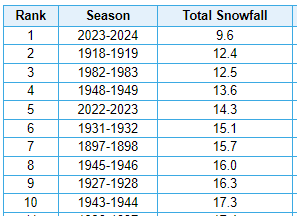
Of course, @michsnowfreaklikes to point out a 6.0" observation from the winter of 1889-1890, but I'm guessing that lacks daily resolution as it is not part of the threaded record, which begins in 1890-1891.
-
12 hours ago, mississaugasnow said:
Toronto had nearly 2 sub 20" winters in 3 years back in 2009-10 (20.6") and 11-12 (16"). 2011-12 will probably be very difficult to ever get lower for Toronto as 16" is insanely low.
Those stats might also be why I'm more prone to start discussing futility records since Toronto has been racking up a few recently (Last 20 years)
Same in Ohio. Just look at Cleveland the last two years. There hasn't been an above normal season since 2014-2015, and that was actually slightly below the normal in effect at the time [normal snowfall dropped several inches with the 1991-2020 update]. 2013-2014 was the last time a season came in above the existing normals.
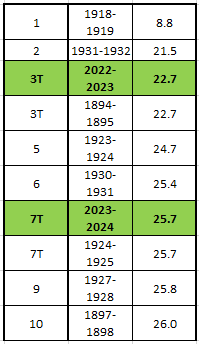
Note all of the low snow years were from the city office data. The heaviest snow occurs south and especially east of the city (see below), so we can conclude snowfall would have been heavier at the airport location. Of course, snowfall measurement procedure has also changed over that time frame.
Of note, Alfred Hyde was a long time cooperative observer for the Smithsonian Institution who kept temperature, precipitation and snowfall records back to 1854-1855. His lowest snowfall winter was 1865-66 with 21.6 inches. Looking at this, we can conclude only one year on record had substantially less snow than last winter dating all the way back to the mid 19th century: 1918-1919. The other two years with less (1931-1932, 1865-1866) were minor differences (1.2 inches, and 0.1 inches, respectively). Also of note, prior to last winter, there had never been less than 30 inches observed in a season since records moved to the airport [around 1940, give or take a year]. The last time less than 30 inches was observed was 1932-1933. There is a good chance that metric is about to be exceeded for the second consecutive winter, barring some late season action.
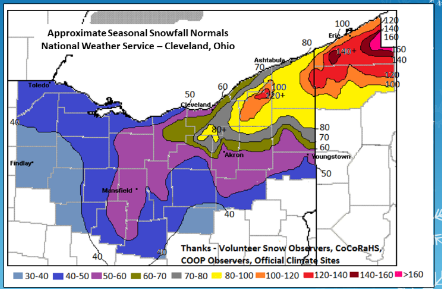
-
2 hours ago, Lava Rock said:
Over what time period? I'm just going back to 2009 when we moved back to maine
Sent from my SM-G981U1 using Tapatalk
Seems unlikely that he's had ten years under 24 inches. The official records at Portland, which date to 1881, show the lowest annual total at 27.5 inches.
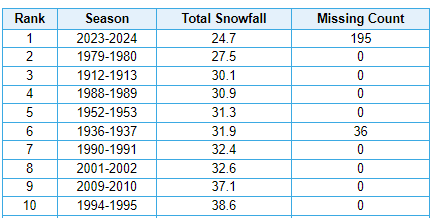
-
28 minutes ago, donsutherland1 said:
Boston has never had two consecutive seasons with less than 20" of snow. The lowest two season average was 17.4" (1979-80 and 1980-81).
Interesting. I just checked Pittsburgh, which is still on track for two consecutive seasons of 20” or less. Looks like it’s only happened once dating back to 1879, but it was three seasons in a row (1930-31, 1931-32, and 1932-33). Of course, that was when observations were still downtown at the city office, which is about 400’ lower in elevation and averaged about a foot less than at the airport (although some of that is probably attributable to changes in observation procedure). Prior to last year, there had only been three years since then with less than 20” (1937-38, 1973-74 & 1990-91).
-
 1
1
-
-
Just now, TheClimateChanger said:
Perhaps most insane is the 47.9F mean at Jefferson County Airport, at more than 1800 feet elevation, would be third warmest on record at low-elevation Harrisburg in the southern part of the State!
-
At DuBois, the first 17 days of March have been 2F warmer than the same period in any of the year since records began in 1963:

At Bradford, the first 17 days of March have been 2.7F warmer than the same period in any other year dating back to 1958:
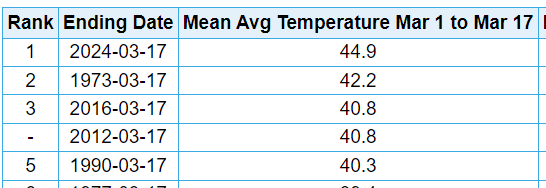
-
In what has become a common refrain, yet another scorching start to the month in the Commonwealth.
Harrisburg

Williamsport
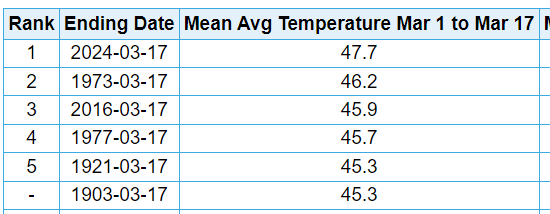
Erie
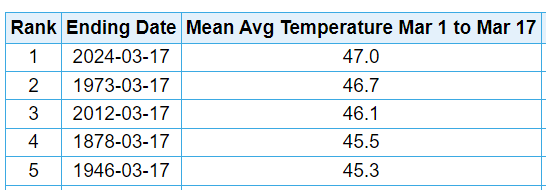
Philadelphia
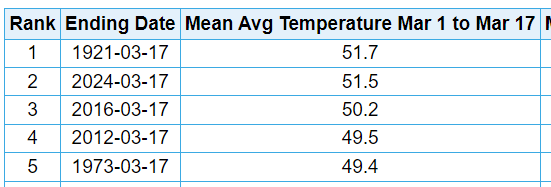
Pittsburgh
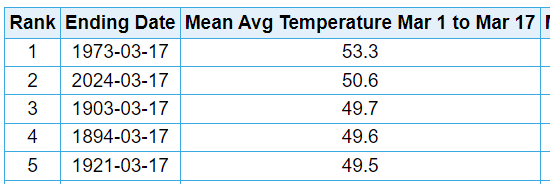
-
Second warmest start to the month, through yesterday.
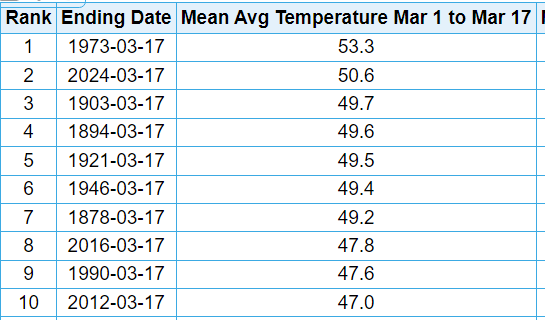
-
On 3/15/2024 at 6:50 AM, WestMichigan said:
There is a subforum for this - https://www.americanwx.com/bb/forum/18-climate-change/ If every post you made wasn't 100% related to this subforum I wouldn't be complaining, but since that is all you do, take it over there will you.
This is a good discussion for the banter thread. Much more topical than most posts that are made in the banter threads.
-
-
On 3/13/2024 at 5:57 PM, michsnowfreak said:
For a visual aid, see above. It's like talking to a brick wall. Mean temperature vs max temps are two different things. It would be like comparing six 2" snowfalls to one 12" snowstorm.
Last summer the hottest temperature at DTW was 90°. To be honest I would prefer a hotter dry summer over a warm humid one.
Considering last year was overall a very pleasant summer in an era of hot summers, and we have an El Nino transitioning to La Nina, I definitely am expecting a hot summer this year. But it would be interesting if we could actually get heat waves and some cool shots instead of just steady warm and humid.
The so-called hottest summer on record was downright pleasant in Detroit outside of a single week. Even including the 7-day heat wave, it was a moderate summer and fairly mild by modern standards.
The mean temperature of 71.2F places 57th in the threaded record. In the past 9 years, only 2015 & 2023 have been cooler (and both by very small margins). By contrast, 2016 was nearly 4F warmer than 1936!
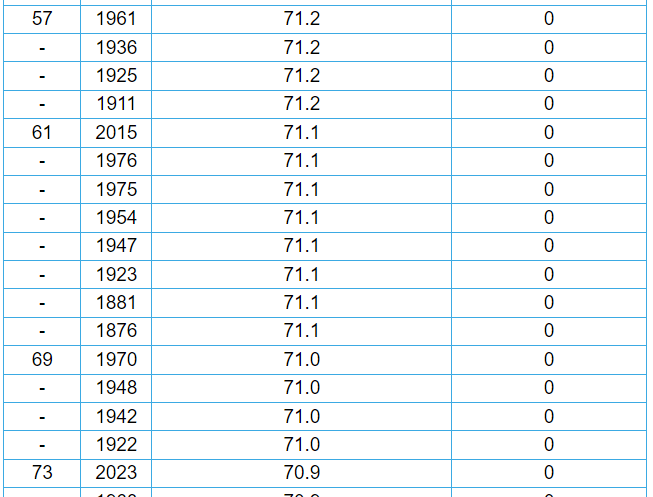
And to be honest, it makes much more sense to compare this to records observed at City Airport (DET) since that it was where the official temperatures were observed in 1936. On that metric, it was the 27th COLDEST summer out of 90 years of records.

Incredibly, removing one 7-day stretch would drop the summertime mean to 69.9F. I know you can't do this, but it gives a much better reading of the overall character of the summer. And that was one of low humidity and generally mild weather, with cool overnight lows, punctuated by a few episodes of extreme heat, including one colossal 7-day stretch in early to mid-July. At these levels, you'd be looking at the 12th coolest of 90 years at DET and 44th coolest of 150 years in the threaded Detroit area records.
The 59.5F mean summer minimum is 5th lowest on record, out of 90 years' worth of observations at Detroit City Airport. That value has not been exceeded in recent decades since the volcanically cooled summer of 1992, and even then only by a negligible amount [59.3F]. In the threaded record, it's only 26th coldest of 150 years, as the coldest minima are dominated by the 1960s-1980s records from DTW when it radiated like a freezer at night [developed in low density suburb]. Still pretty cold either way. Ignoring the 7-day inferno [July 8-July 14], the mean minima the rest of the summer was just 58.4F, which would easily be the coldest on record at DET and would tie 1875 for 10th coldest in the threaded record.
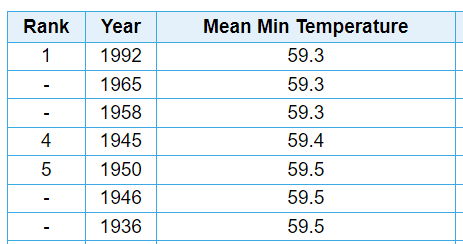
Regarding the heat wave, you can pull up the old records and see the humidity and dry bulb temperatures at 3 periods each day. The mean dewpoint was probably around 55-55.5F, based on those observations. This is less than even the "frigid" July of 2009 when the average dewpoint at Detroit was a comfortable 56.3F. During the worst of the heat wave, humidity was generally very low. Under these conditions, the heat index would not greatly vary from the dry bulb temperature. Despite the extreme temperatures, there have been more dangerous conditions in recent summers when factoring in the cumulative effect of high dewpoints and temperatures. The most extreme heat indices in Detroit were experienced not in 1936, but in 1995, when triple digit temperatures were combined with dewpoints nearing 80F - rather than in the 50s.
The combination of generally moderate temperatures and very low humidity would have made the summer of 1936 more comfortable than the majority of recent summers in Detroit. If those same conditions repeated this year, and I tried to point out the upper 90s/100s as the result of climate change, you would no doubt change tune and attempt to rebut my assertion by going on about how cool and dry it was for the majority of the summer.
-
4 hours ago, michsnowfreak said:
For a visual aid, see above. It's like talking to a brick wall. Mean temperature vs max temps are two different things. It would be like comparing six 2" snowfalls to one 12" snowstorm.
Last summer the hottest temperature at DTW was 90°. To be honest I would prefer a hotter dry summer over a warm humid one.
Considering last year was overall a very pleasant summer in an era of hot summers, and we have an El Nino transitioning to La Nina, I definitely am expecting a hot summer this year. But it would be interesting if we could actually get heat waves and some cool shots instead of just steady warm and humid.
Looks like you guys are doing alright. 4 of the top 16 years in the past 13 summers [with a 150 year period of record]. At least it's not the 19th century. I don't see a single year before 1916.
-
Some of the co-op data has also, unfortunately, been manipulated.
If we compare the raw data from Saginaw to the "official" records, we see numerous instances of mistakes and/or temperatures just completely made up and not borne out by the actual observation. It looks like there's potential issues on the 14th, 23rd and 29th from July 1936. The high on the 14th on the record was observed as 92F, curiously below the set max of 98F on the previous day. I've seen this in the past and the temperature is often bumped up the high temperature, assuming the observer somehow reset the temperature device afterwards. Of course, I would surmise that the set max was simply incorrectly reported and it is showing the max set on the prior day, but bumping it up one day to the day it impacts. In this case, they simply made up a 104F high on that date! Unbelievable - that's the sixth hottest temperature observed at Saginaw, and it wasn't even observed. The high was clearly reported as 92F! I mean maybe you could make a case for adjusting to the set max, but simply making up a value - what?!? And not only making up a value, but generating one of the hottest readings in the entire threaded record from thin air.
Same thing on the 23rd. High reported as 79F, but goes in the "official" books as 85F. Not only 6F above the actual observation, but 5F above the reported set max from the prior day. Again, it's one thing to bump it up to the set max. But why make up a reading?!?
On the 29th, they bumped the observed high of 70F up to the 77F set max from the prior day. Reasonable, but again relies on the assumption that the observer was reporting the set max from that day - and not the prior day's set maximum. That's how it was supposed to be reported, but you can see how that could be screwed up. Easier to mess that up than somehow reseting the max thermometer a second time without reporting it, IMO.
Also, while not a big error, the high on the 10th is clearly reported as 106F, not 107F as shown in the "official" records.

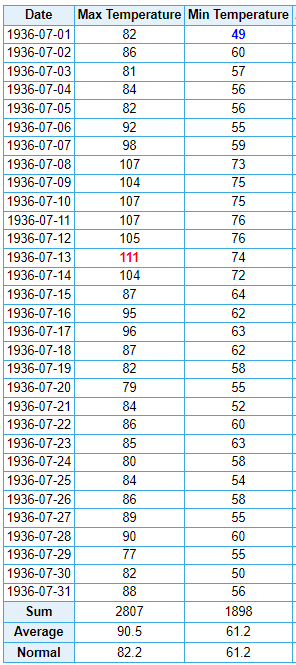
Admittedly, the 104F on the 14th is more in line with surrounding observations, but it's worth noting that a sharp cold front passed through that day, and would have made it to Saginaw earlier. It could have generated a wind shift off of the bay into the city. Either way, there shouldn't be record temperatures made up from thin air without justification. The effect of all these errors, irregularities and/or adjustments is to bump up the monthly mean high by 0.8F and the monthly mean average by 0.4F.
The "adjustment" to the 29th also has the effect of deleting what would be the third coolest maximum temperature on record for July 29th in Saginaw.

So we're going to delete the 70F high because it was maybe (possibly) 77F the previous day when the observer reset the thermometer? Not even certain about that, but maybe. I mean I can see making those adjustments to the climate record [USHCN, GHCN] since there's an explicit adjustment for TOBs, so you want to make sure it's being applied properly. But these are unadjusted values presented for informational purposes only - not for any sort of climate research. What in the world is the justification for adjusting the ThreadEx values?
-
 1
1
-
-
Just for the record, when you compare the raw data from Flint and Saginaw to Detroit, a good chunk of the difference (admittedly, not all - but a good chunk) is completely explainable by the fact that the old Co-op data was not gathered on a midnight-to-midnight time frame, but rather late afternoon.

A 5 pm observation time adds about 1F to the mean temperature relative to a day ending at midnight. Obviously, this is not a problem in the Detroit threaded record since it's always been a manned weather bureau station [with a midnight to midnight day].

Understanding Time of Observation Bias | Climate Etc. (judithcurry.com)
-
Here are Detroit's hottest summers on record. Just look how unbelievably hot it was in 1933! I guess I was wrong!
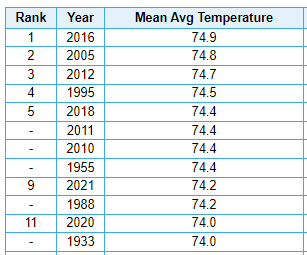
Cue rant about Urban Heat Island Effect in 5, 4, 3, 2, 1!
-
 1
1
-
 1
1
-
 1
1
-
 1
1
-
-
It's important to note when people complain about adjustments to the temperature record, what they are really saying is that they want to use flawed data because it gives them a more favored result. Time of observation makes a HUGE difference, especially in the summertime when weather variance tends to be at an annual minimum. We know this, and we correct for it.
-
 1
1
-
-
14 hours ago, ChescoWx said:
I have been working with the great folks at the Delaware Environmental Observing System (Thanks to Chris!!) to add even more weather observation points and stations across Chester County PA. With the updated data and summer coming I thought I would run an analysis of Summer (June-August) temperatures across the County from 1895 through last summer (now with 25 Chester County Stations at least partially in the data since 1895 and 15 current observation sites included). Overall in the non-adjusted data there is only as expected normal cyclical warm and cool cycles but I thought I would show you a comparison of the post observation adjustment applied by the the National Center of Environmental Information (NCEI) who have applied an incredible 111 consecutive years of post observation adjustments to chill the actual observations to each and every summer from 1895 through 2005 and have now every year since 2005 now applied a warming adjustment. As you can see in the trend lines the orange non-adjusted and blue adjusted paint a far different rate of our rate of warming. My friend Charlie will of course tell us these 111 straight years of cooling adjustments and now 20 years of warming are science based.....
I don’t understand this obsession with using flawed data. Why would you use the unadjusted numbers when they have known biases? How does that make more sense than adjusting for the biases?
-
 1
1
-
 1
1
-
-
Summer is almost certain to be a scorcher. Just looking over the numbers for some recent summers, and it's insane. At Toledo, 3 of the top 5 hottest summers have occurred this decade [and it's only 4 years old]. At Mansfield, Ohio, the top 2 hottest summers have occurred in the past 4 years. At Akron-Canton, ALL of the top 5 hottest summers have occurred in the past 8 years. Cleveland has lucked out a bit on the summer heat front, but still 4 of the top 8 have occurred in the past 14 years, and 5 of the top 8 have occurred in the past 19 years. These are all long period of record sites.
Despite all this, we'll still hear about how much hotter it was in the 1930s!

-
2 hours ago, Chambana said:
Lawns are abnormally green for March 12th lol, I don’t remember this even during morch.
I wonder if the enhanced atmospheric carbon dioxide helps green things up too. Was 394 ppm in 2012, and today it’s 425.
-
Wow, can you imagine this today?!? -20F in north central Ohio on March 12.

-
16 minutes ago, LibertyBell said:
wow it's not even summer yet, what are the implications for the summer for these places?



-
On 3/10/2024 at 8:03 AM, mahantango#1 said:
I don't think it's a question if it hits 70 at mdt, but these above and way above normal days are pushing the fruit trees and all the other foliage way too soon. Last year a fruit farm (Blylers) about 10 miles away as the crow flies lost their whole strawberry crop in May with that frost and freezes that month.
Wasn't a good year in western Pennsylvania either. I know Soergel's had to cancel their strawberry festival last year, although they did get some strawberries later in the season after it started raining again. Looking like fruit growers are going to have a tough time navigating this new climate. Spring just doesn't seem delayed enough anymore to retard plant growth sufficiently to counter the threat of spring frosts and freezes.
-
 2
2
-
-

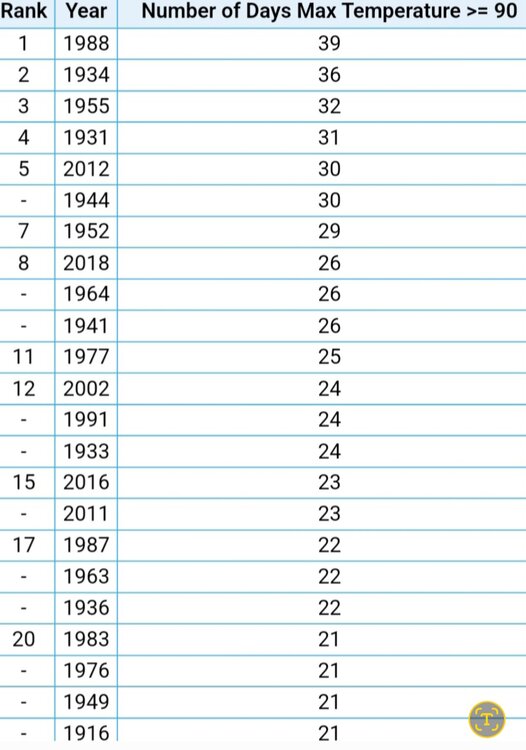
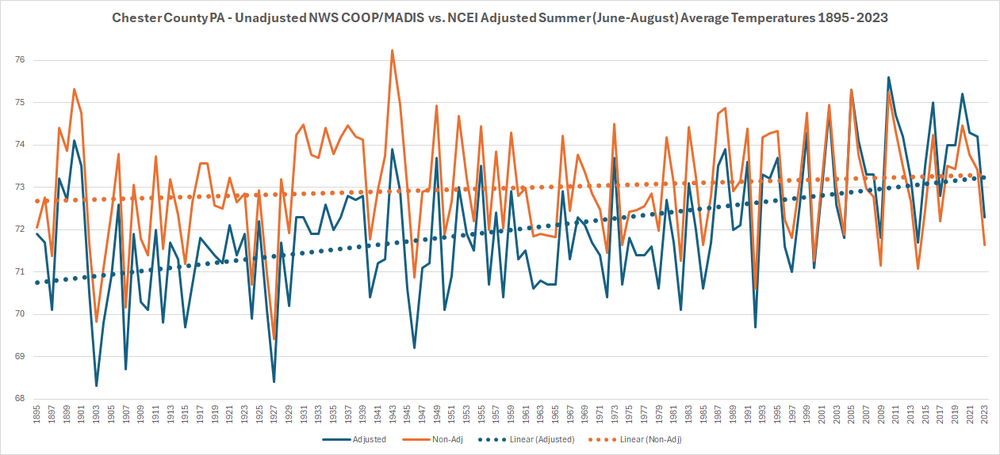
March 2024 General Discussion
in Lakes/Ohio Valley
Posted
I said from Toledo to DTW airport. All of the records prior to the mid 1950s are from the city proper. Of course, it's a bit longer drive out to the airport. The snowfall records were retrieved from xMacis, which has nothing prior to 1890-91.